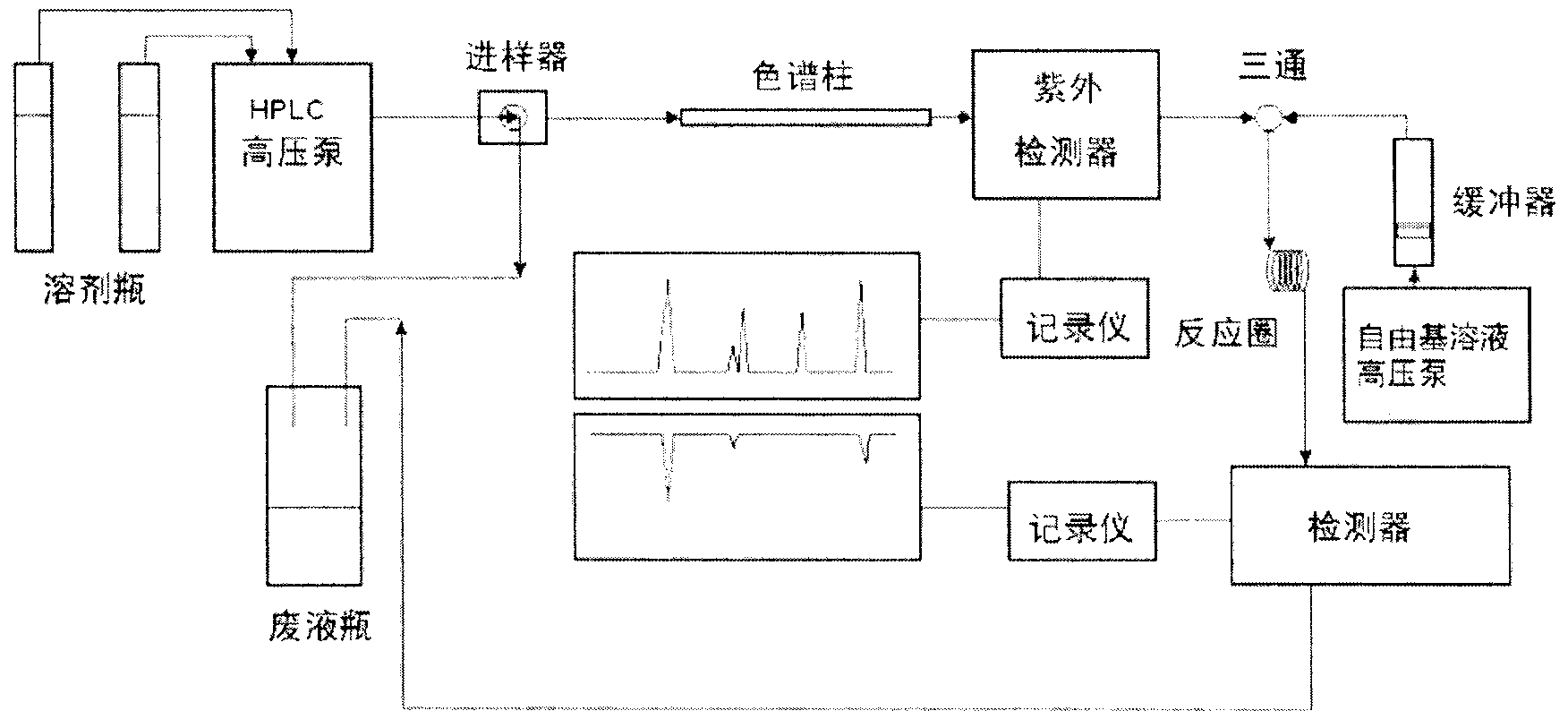Method for detecting antioxidants in vegetable oil or animal fat
A technology for antioxidant substances, animal and vegetable oils and fats, applied in the field of high performance liquid chromatography, can solve the problems of not being used to detect antioxidant substances, poor separation effect, etc., and achieve simple operation, time saving, high sensitivity and wide sources. Effect
- Summary
- Abstract
- Description
- Claims
- Application Information
AI Technical Summary
Problems solved by technology
Method used
Image
Examples
Embodiment 1
[0023] Example 1: Detection of antioxidant substances in corn germ oil
[0024] 1 device
[0025] device attached figure 1 connect. The HPLC system is HP1050. Including HPLC high pressure pump, autosampler, DAD detector, equipped with AlltimaHPLC silica gel column (3μm, 150×4.6mm i.d.). Data processing with HP ChemStation. A UV-visible absorption detector (Applied Biosystems, model 785A, Forster City, USA) was connected to a recorder (Kipp & Zonen BD40; Delft, Netherlands) to record the change in absorbance of the free radical solution. Determination of galvinoxyl · The detection wavelength is 425nm. A buffer (superloop. GE Healthcare Bio-Sciences AB, Uppsala, Sweden, 150 ml) was connected to an HPLC pump (Gynkotek, 300) to deliver the free radical solution to the reaction circle through the "tee". The material of the reaction ring is PEEK, the model is 10.0m×0.25mm i.d.
[0026] 2 Sample and solvent treatment
[0027] Dissolve 1.000 g of corn germ oil in 100 mL of n-...
Embodiment 2
[0036] Example 2: Detection of antioxidant substances in olive oil
[0037] 1 device: the same as embodiment one.
[0038] 2 Sample and solvent treatment: Dissolve 1.0 g of olive oil in 100 mL of n-hexane to prepare a 10 mg / mL solution. All samples and solvents required for HPLC analysis were filtered through a 0.45 μm filter membrane.
[0039] 3 Preparation of free radical solution: same as Example 1.
[0040] 4HPLC analysis method
[0041] Eluent A: n-hexane; Eluent B: tert-butyl methyl ether, flow rate 0.8mL / min. The sample concentration is 10 mg / mL, and the injection volume is 20 μL. The detection wavelength is 292nm. The gradient elution program is 0-15min, B: 8%-12%; 15-20min, B: 12%-20%; 20-30min, B: 20%-50%; 30-32min, B: 50%- 8%; 32-45min, B: 0%.
[0042] 4 Online system parameter setting
[0043] HPLC flow rate 0.8mL / min, detection wavelength 292nm. The free radical detection wavelength is 425nm. The free radical concentration is 0.002mmol / L, the free radica...
Embodiment 3
[0046] Example 3: Detection of Antioxidant Substances in Butter
[0047] 1. Device: Same as in Example 1, but the reaction circle is changed to 30.0m in length.
[0048] 2 Sample and solvent treatment: Take 1.0 g of butter and dissolve it in 100 mL of n-hexane to prepare a 10 mg / mL solution. All samples and solvents required for HPLC analysis were filtered through a 0.45 μm filter membrane.
[0049] 3 Preparation of free radical solution: same as Example 1.
[0050] 4HPLC analysis method
[0051] Eluent A: n-hexane; Eluent B: tert-butyl methyl ether. Flow rate 1.2 mL / min. The sample concentration is 10 mg / mL, and the injection volume is 20 μL. The detection wavelength is 280nm. The gradient elution program is 0-15min, B: 0%-5%; 15-20min, B: 5%-10%; 20-30min, B: 10%-25%; 30-32min, B: 25%- 0%; 32-45 min, B: 0%.
[0052] 4 Online system parameter setting
[0053] HPLC flow rate 1.2mL / min, detection wavelength 280nm. The free radical detection wavelength is 425nm. The f...
PUM
| Property | Measurement | Unit |
|---|---|---|
| Wavelength | aaaaa | aaaaa |
Abstract
Description
Claims
Application Information
 Login to View More
Login to View More - R&D
- Intellectual Property
- Life Sciences
- Materials
- Tech Scout
- Unparalleled Data Quality
- Higher Quality Content
- 60% Fewer Hallucinations
Browse by: Latest US Patents, China's latest patents, Technical Efficacy Thesaurus, Application Domain, Technology Topic, Popular Technical Reports.
© 2025 PatSnap. All rights reserved.Legal|Privacy policy|Modern Slavery Act Transparency Statement|Sitemap|About US| Contact US: help@patsnap.com

